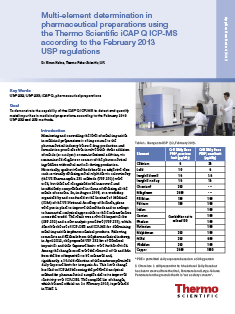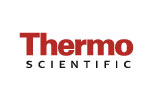Knowledge Base

View1
- IRMS
- Delta V Advantage
- Flash 1112 HT
- GC
- 15N
- Taurine
- View
- Add to Favorites
- Send Link
- Private
Determination of the natural abundance δ15N of taurine by gas chromatography–isotope ratio measurement mass spectrometry
Illa Tea*, Ingrid Antheaume, Jorick Besnard and Richard J. Robins
Elucidation of Biosynthesis by Isotopic Spectrometry Group, Unit for Interdisciplinary Chemistry: Synthesis-Analysis-Modelling University of Nantes–CNRS UMR6230, 2 rue de la Houssinie`re, BP 92208, F-44322 Nantes, France
Rapid Communications in Mass Spectrometry (2010), V24, pp3380–3386, doi: 10.1002/rcm.4784
Goal: The measurement of the nitrogen isotope ratio of taurine (2-aminoethanesulphonic acid) in biological samples has a large number of potential applications. Taurine is a small water-soluble molecule which is notoriously difficult to analyze due to its polarity and functionality. A method is described which allows the determination of the natural abundance d15N values of taurine and structural analogues, such as 3-amino-1-propanesulphonic acid (APSA), by isotope ratio mass spectrometry interfaced to gas chromatography (GC-irm-MS).

View1
- View
- Add to Favorites
- Send Link
- Private
Thermo Scientific LC IsoLink
Thermo Fisher Scientific, Bremen, Germany
BR30039

View0
- IRMS
- Gas Bench
- Nitrogen Isotopes
- Nitrification
- View
- Add to Favorites
- Send Link
- Private
Characteristics of the δ15N (NO3-) distribution and its drivers in the Changjiang River estuary and adjacent waters
Wentao Wang (1,2,3), Zhiming Yu (1,2), Xiuxian Song (1,2), Zaixing Wu (1,2), Yongquan Yuan (1,2), Peng Zhou (1,2,3) and Xihua Cao (1,2)
1) Key Laboratory of Marine Ecology and Environmental Science, Institute of Oceanology, Chinese Academy of Sciences, 2) Laboratory of Marine Ecology and Environmental Science, Qingdao National laboratory for Marine Science and Technology, 3) University of Chinese Academy of Sciences, 4
Chinese Journal of Oceanology and Limnology (2016), pp1-16
Goal: In this study, we conducted investigations in the Changjiang (Yangtze) River estuary and adjacent waters (CREAW) in June and November of 2014. We collected water samples from different depths to analyze the nitrogen isotopic compositions of nitrate, nutrient concentrations (including inorganic N, P, and Si), and other physical and biological parameters, along with the vertical distribution and seasonal variations of these parameters. The compositions of nitrogen isotope in nitrate were measured with the denitrifier method.

View1
- European regulation
- 18O
- wine
- View
- Add to Favorites
- Send Link
- Private
Chapter 43: Determination of the isotopic ratio 18O/16O of the water contents in wines
European Commission
EU Brussels, Belgium
COMMISSION REGULATION (EC) No 822/97 of 6 May 1997; Official Journal of the European Communities
Goal: The isotopic ratio 18O/16O is determined by mass spectrometry of isotopic ratios (MSIR) from ionic currents m/z 46 (12C16O18O) and m/z 44 (12C16O2) produced by carbon dioxide obtained after an exchange with the water in wine according to the reaction: C16O2 + H218O ↔ C16O18O + H216O.

View2
- IRMS
- HPLC
- Carbon isotopes
- Amino acids
- View
- Add to Favorites
- Send Link
- Private
A three-phase liquid chromatographic method for δ13C analysis of amino acids from biological protein hydrolysates using liquid chromatography–isotope ratio mass spectrometry
Colin I. Smith, Benjamin T. Fuller, Kyungcheol Choy, Michael P. Richards
Department of Human Evolution, Max Planck Institute for Evolutionary Anthropology, Leipzig 04103, Germany
Analytical Biochemistry (2009), V390, pp165–172, doi: 10.1016/j.ab.2009.04.014
Goal: We report a three-phase chromatographic method for the separation and analysis of δ13C values of underivatized amino acids from biological proteins (keratin, collagen, and casein) using liquid chromatography–

View0
- GC-IRMS
- Nitrogen isotopes
- Zooplankton
- View
- Add to Favorites
- Send Link
- Private
Environmental perturbation effects on baseline δ15N values and zooplankton trophic flexibility in the southern California Current Ecosystem
Moira Décima (1), Michael R. Landry (1) and Brian N. Popp (2)
1) Scripps Institution of Oceanography, University of California at San Diego, La Jolla, California, 2) Department of Geology and Geophysics, University of Hawaii, Honolulu, Hawaii
Limnology and Oceanography (2013), V58(2), pp624–634 , doi: 10.4319/lo.2013.58.2.0624
Goal: Nitrogen isotopic compositions of zooplankton in the California Current Ecosystem (CCE) are known to vary over inter-annual scales of climate variability, but the extent to which those changes are driven by variations in baseline phytoplankton δ15N values vs. zooplankton trophic position (TP) is poorly resolved. We use field samples collected during a large natural environmental perturbation, the 1998–1999 alternation between El Niño and La Niña states, to test the ability of large dominant CCE zooplankton Euphausia pacifica and Calanus pacificus to alter their TPs in response to environmental variability.

View1
- GC-IRMS
- LC-IRMS
- Bone Collagen
- View
- Add to Favorites
- Send Link
- Private
Comparison of liquid chromatography–isotope ratio mass spectrometry (LC/IRMS) and gas chromatography–combustion– isotope ratio mass spectrometry (GC/C/IRMS) for the determination of collagen amino acid δ13C values for palaeodietary and palaeoecological reconstruction
Philip J. H. Dunn, Noah V. Honch and Richard P. Evershed
Organic Geochemistry Unit, Bristol Biogeochemistry Research Center, School of Chemistry, University of Bristol, Cantock’s Close, Bristol BS8 1TS, UK
Rapid Communications in Mass Spectrometry (2011), V25, pp2995–3011, doi: 10.1002/rcm.5174
Goal: Results are presented of a comparison of the amino acid (AA) δ13C values obtained by gas chromatography- combustion-isotope ratio mass spectrometry (GC/C/IRMS) and liquid chromatography- isotope ratio mass spectrometry (LC/IRMS). Although the primary focus was the compound-specific stable carbon isotope analysis of bone collagen AAs, because of its growing application for palaeodietary and palaeoecological reconstruction, the results are relevant to any field where AA δ13C values are required. We compare LC/IRMS with the most up-to-date GC/C/IRMS method using N-acetyl methyl ester (NACME) AA derivatives.

View0
- LC IsoLink
- Compound Specific Isotope Analysis
- Honey
- HPLC
- Isotope Ratio MS
- Sugar
- View
- Add to Favorites
- Send Link
- Private
irm-LC/MS: δ13C of Carbohydrates in Honey
Andreas W. Hilkert, Michael Krummen, Dieter Juchelka
Thermo Fisher Scientific, Bremen, Germany
AN30024
Goal: Sugars are one of the biggest and most common families of molecules in life. They serve as energy resources, the backbone of DNA and RNA, the carrier of biologically active compounds and as structure building material of plants. Sugars can carry information of their origin and processing.

View2
- HR-ICPMS
- Element 2 XR
- Neptune Plus
- B isotopes
- Foraminifera
- View
- Add to Favorites
- Send Link
- Private
Determination of δ11B by HR-ICP-MS from Mass Limited Samples: Application to Natural Carbonates and Water Samples
Sambuddha Misra (1), Robert Owen (1,2), Joanna Kerr (1), Mervyn Greaves (1) and Henry Elderfield (1)
1) University of Cambridge, Department of Earth Sciences, Godwin Laboratory for Paleoclimate Research, Downing Street, Cambridge CB2 3EQ, United Kingdom, 2) University of Oxford, Department of Earth Sciences, Oxford OX1 3PR, United Kingdom
Geochimica et Cosmochimica Acta (2014), V140, pp531-552, doi: 10.1016/j.gca.2014.05.047
Goal: We present an improved method for accurate and precise determination of the boron isotopic composition (11B/10B) of carbonate and water samples using a mineral acid matrix and HR-ICP-MS. Our method for δ11B determination utilizes a micro-distillation based boron purification technique for both carbonate and seawater matrices.

View3
- IRMS
- EA/GC/LC IsoLink
- Official Methods
- Isotope Fingerprints
- Food Authenticity
- Adulteration
- Fraud
- View
- Add to Favorites
- Send Link
- Private
Are there official methods for food and beverage product origin, authenticity and label claims?
Thermo Fisher Scientific, Bremen, Germany
SN30414
Goal: This smart note shows official methods for isotope analysis using isotope ratio mass spectrometry.

View4
- IRMS
- EA/GC/LC IsoLink
- Isotope Fingerprints
- Food Authenticity
- Adulteration
- Fraud
- View
- Add to Favorites
- Send Link
- Private
How can stable isotopes be used to determine origin and authenticity of food and beverage products?
Thermo Fisher Scientific, Bremen, Germany
SN30410
Goal: This smart note answers the question how isotopes can be used to determine origin and authenticity of food and beverage products.

View1
- IRMS
- EA/GC/LC IsoLink
- Isotope Fingerprints
- Food Authenticity
- Adulteration
- Fraud
- View
- Add to Favorites
- Send Link
- Private
Food and beverage fraud prevention using stable isotope fingerprints
Christopher Brodie, Oliver Kracht, Dieter Juchelka, Jens Radke and Andreas Hilkert
Thermo Fisher Scientific, Bremen, Germany
PN30397
Goal: This note demonstrates how stable isotope fingerprints offer conclusive answers on questions associated with origin, adulteration and correct labeling of food and beverage products.

View3
- IRMS
- EA IsoLink
- Isotope Fingerprints
- Food Fraud
- Coffee
- Geographical Origin
- View
- Add to Favorites
- Send Link
- Private
EA-IRMS: Tracing the geographical origin of coffee using isotope fingerprints
Maryam Weigt, Christopher Brodie and Oliver Kracht
Thermo Fisher Scientific, Bremen, Germany
AN30418
Goal: In this application note we show hydrogen and oxygen stable isotope measurements on roasted coffee samples measured with the Thermo Scientific™ EA IsoLink™ IRMS System. We were able to trace the origin of coffee beans based on unique trends observed from their isotopic fingerprints.

View1
- IRMS
- EA IsoLink
- Isotope Fingerprints
- Food Fraud
- Sugar
- View
- Add to Favorites
- Send Link
- Private
EA-IRMS: Testing sugar package label claims using carbon isotope fingerprints
Maryam Weigt, Christopher Brodie and Oliver Kracht
Thermo Fisher Scientific, Bremen, Germany
AB30424
Goal: In this application brief we show carbon isotope measurements on sugar and distinguish between cane and beet sugars and verify package label claims

View1
- IRMS
- EA IsoLink
- Isotope Fingerprints
- Tomatoes
- Organic Vegetables
- View
- Add to Favorites
- Send Link
- Private
EA-IRMS: Detecting organic grown vegetables
Christopher Brodie and Oliver Kracht
Thermo Fisher Scientific, Bremen, Germany
AB30399
Goal: In this application brief we show nitrogen isotope measurements on tomato samples and are able to conclude which tomatoes were grown using organic fertilizers and which tomatoes were grown using synthetic fertilizers.

